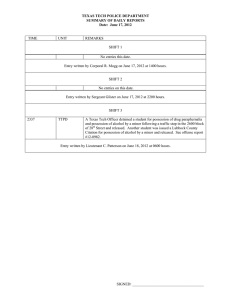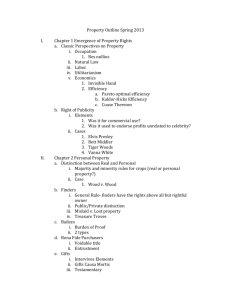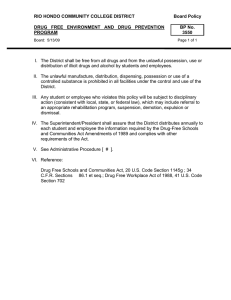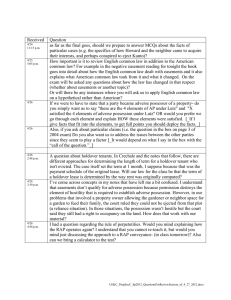Sovereignty Sovereignty— Johnson v. M’INtosh
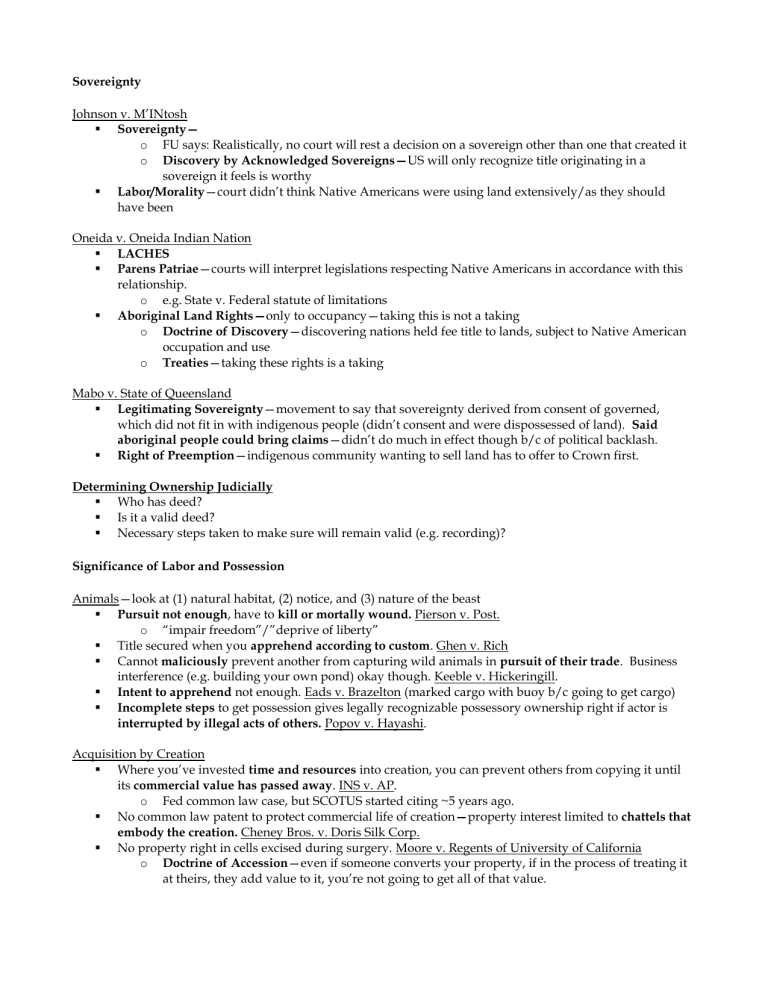
Sovereignty
Johnson v. M’INtosh
Sovereignty— o FU says: Realistically, no court will rest a decision on a sovereign other than one that created it o Discovery by Acknowledged Sovereigns—US will only recognize title originating in a sovereign it feels is worthy
Labor/Morality—court didn’t think Native Americans were using land extensively/as they should have been
Oneida v. Oneida Indian Nation
LACHES
Parens Patriae—courts will interpret legislations respecting Native Americans in accordance with this relationship. o e.g. State v. Federal statute of limitations
Aboriginal Land Rights—only to occupancy—taking this is not a taking o Doctrine of Discovery—discovering nations held fee title to lands, subject to Native American occupation and use o Treaties—taking these rights is a taking
Mabo v. State of Queensland
Legitimating Sovereignty—movement to say that sovereignty derived from consent of governed, which did not fit in with indigenous people (didn’t consent and were dispossessed of land). Said
aboriginal people could bring claims—didn’t do much in effect though b/c of political backlash.
Right of Preemption—indigenous community wanting to sell land has to offer to Crown first.
Determining Ownership Judicially
Who has deed?
Is it a valid deed?
Necessary steps taken to make sure will remain valid (e.g. recording)?
Significance of Labor and Possession
Animals—look at (1) natural habitat, (2) notice, and (3) nature of the beast
Pursuit not enough, have to kill or mortally wound. Pierson v. Post. o “impair freedom”/”deprive of liberty”
Title secured when you apprehend according to custom. Ghen v. Rich
Cannot maliciously prevent another from capturing wild animals in pursuit of their trade. Business interference (e.g. building your own pond) okay though. Keeble v. Hickeringill.
Intent to apprehend not enough. Eads v. Brazelton (marked cargo with buoy b/c going to get cargo)
Incomplete steps to get possession gives legally recognizable possessory ownership right if actor is
interrupted by illegal acts of others. Popov v. Hayashi.
Acquisition by Creation
Where you’ve invested time and resources into creation, you can prevent others from copying it until its commercial value has passed away. INS v. AP. o Fed common law case, but SCOTUS started citing ~5 years ago.
No common law patent to protect commercial life of creation—property interest limited to chattels that
embody the creation. Cheney Bros. v. Doris Silk Corp.
No property right in cells excised during surgery. Moore v. Regents of University of California o Doctrine of Accession—even if someone converts your property, if in the process of treating it at theirs, they add value to it, you’re not going to get all of that value.
Adverse Possession
LACHES—have you left the claim too long?
4 (+1) Requirements
(1) Exclusive, Actual possession
(2) Open and Notorious
(3) Continuous and Uninterrupted
(4) Hostile/Adverse
(+1) Claim of Right
Color of Title—deed, merely void—gets you everything title describes, not just parts you actually possess
Exclusive & Actual
Possession not exclusive where other people using property. Marengo Cave v. Ross (seems wrong, b/c
Cave Co. was exercising exclusive right to admit people to cave).
Open & Notorious
Do NOT need: actual occupation, cultivation, residence, or permanent useful improvements—enough that you exercise visible and notorious acts of ownership over land in controversy. Ewing v. Burnet
Underground—not O&N unless above ground owner knows that their land being possessed. Marengo
Cave v. Ross. (generalized, not O&N unless TO knows their land being possessed).
Minor border encroachments NOT O&N. Mannillo v. Gorski; McCarty v. Sheets (Ct. doesn’t say this directly). o Minor border cases often turn on notice, rather than adversity.
Continuous & Uninterrupted
Customary use enough—don’t have to be on land all the time. Howard v. Kunto.
Intermittent use not C&U. Ennis v. Stanley (doesn’t seem this applies anymore).
Mowing/raking not C&U enough. McCarty v. Sheets (Ct. doesn’t say this directly)
Hostile/Adverse
Adversity does NOT have to be intentional—satisfied by entry and continued possession under mistaken belief that possessor has title to lands in dispute. Manillo v. Gorski.
Mistake not enough, have to intentionally possess another’s land. Ennis v. Stanley (bad opinion).
NOT adverse if you have permission. Wallis Bay
Mowing/raking land not hostile. McCarty v. Sheets (Ct. doesn’t say this directly)
Claim of Right
Ejectment action can be based upon peaceable possession—only have to show relative strength of claims. Will win against anyone but TO. Tapscott v. Lessee of Cobbs
Ruthless usurpers may lose claim. Wallis Bay (FU says even if had claim before, would have lost b/c waited to answer letter—makes them a ruthless usurper).
Color of Title
Has to describe right land.
Doesn’t count if describes wrong land (as in Kunto).
Tacking—May tack on previous AP’s time if you’re in privity with them. Howard v. Kunto.
Disabilities—disability has to be both, (1) in the person, and (2) present at the time AP enters
Only count original person’s disability (don’t get credit if successor in interest under disability as well)
International Perspectives
Spratly Islands—court fudged exclusivity to make it more about who property exhibited sovereignty. o 100+ uninhabited islands in the South China Sea. China, Taiwan, Vietnam, Philippines,
Malaysia, and Brunei all claim them. o No state has actual exclusive possession. They’ve got oil. Being claimed as a group.
o It won’t be resolved because there is no sovereign.
U.S. v. Netherlands—case structured as if Spain had gotten something by discovery, and court decided to see if the Netherlands destroyed that something by their action. Netherlands are the adverse possessor, Spain is the title owner. But the court does not go so far as to say that Spain got sovereignty over the island—inchoate title. If the Netherlands had done nothing, the islands would have gone to the
U.S.
Greenland case—court gave all of it to Denmark. Two required elements are intention to act as
sovereign and actually acting as sovereign, and Denmark did both—claimed ownership of all of
Greenland in treaties, and Norway acquiesced. Treaty is an analogy to deed—color of title. Peaceful display of sovereignty is ideal.
Treaties & Efficacies o Efficacies—possession, C&U, O&N, claim of right, reliance by society
Subject to being trumped by treaties if treaty is clear about whom owns territory.
To trump a treaty: acts have to be substantial enough to provide a reasonable possibility o Treaties—trump equities
If have unratified treaty, sometimes people will assert opposite of if treaty asserted— b/c country A had power to grant to B in treaty, must be A’s.
Chad & Libya
Background: Strip of land between two countries, under which was valuable water supply.
Outcome: Very similar to what we see in domestic property cases: (1) who was there first, (2) who asserted authority over the area, (3) who made arrests there.
Indonesia & Malaysia
Background: Small islands near Borneo worth little to anyone other than pirates and turtle-egg gatherers. Borneo and other islands were split between US and Netherlands. Ct looking at whether treaty directly addressing nearby area encompassed these islands as well, or if should be determined based on efficacies.
Outcome: Court based upon efficacies
FU thinks they should have just continued line from earlier treaty to encompass islands in dispute—was reasonable that they intended to achieve closure on issue of islands.
Guyana & Surinam
Background: River is boundary between countries—Surinam owns river. At dispute is 200 miles of
Caribbean Sea, which have oil reserves—where river ends will determine dividing line.
Issue: Question about shores—usually provide lines of extension, but not always (sometimes courts do equitable distribution).
Economic Perspectives
SEE LONG OUTLINE
Property in Light, Air, and Water
Property in Light and Air
NO property rights in light and air. Parker & Edgarton v. Foote.
Property in sunlight—can state a nuisance claim b/c someone blocking your sun. Prah v. Maretti. o Compliance w/zoning laws does not bar nuisance claim. o Plaintiff’s ability to avoid harm is relevant, but not conclusive. o Action in nuisance makes close to reasonable use???
Property in Water
Absolute Ownership—you can use it while your hands are on it, but you can’t stop others’ use o NOT RIPARIAN o AZ underground water doctrine. o Acton v. Blundell (well and coal pits)
Reasonable Use—Can’t unreasonably interfere w/another’s reasonable use o RIPARIAN o Pennsylvania Coal Co. v. Sanderson & Wife o Evans v. Merriwether (natural and artificial uses—can use as much for artificial as like, but can’t interfere w/natural by artificial).
Natural Flow—Riparian owners can do whatever they like, as long as allow it to flow in its natural (1)
course, (2) volume, and (3) quality. o RIPARIAN o Works where water is plentiful.
Prior Appropriation—You own the amount of water you’ve appropriated so long as you’re putting it to beneficial use. o NOT RIPARIAN o Used where water is scarce—AZ uses for surface water
Interests & Estates
Words of Purchase—identify WHO is getting property (or could be getting)
Words of Limitation—limit duration of estate
Have to go by pigeon-holes. Johnson v. Whitton
General Estates
Fee Simple Absolute o Didn’t exist at common-law (before 1600 “and her heirs” indicates Life Estate) o Interpret as FSA unless contrary intent clear by (1) terms of will, (2) context. White v. Brown
Fee Simple Determinable o Charlotte Park—court interpreted to be FSD, even though clearly FSSCS so wouldn’t involve state action (Shelley)
Fee Simple Subject to Condition Subsequent o May be better than FSD b/c you’re not being AP if condition broken and you don’t re-enter o White v. Metropolitan Dade County
Life Estate o Can’t commit waste (Doctrine of Waste)
Permanent impairment
Destruction of property identity (house stocks & bonds)
Any material change to nature of property o Can’t sell without permission of remainderpersons. Baker v. Weedon o Court can only order judicial sale if is in everyone’s best interest. Baker v. Weedon. o If sale of entire property is not in everyone’s best interest, but life tenant will be screwed w/o sale, court may suggest partial sale. Baker v. Weedon
Concurrent Estates—interest-holders viewed, conceptually, as one person (in reality, you have a partial interest in the property, but conceptually, you own the whole thing).
Joint Tenancy o 4 Unities:
Time
Title
Interest
Possession o Survivorship rights o CAN be unilaterally severed (w/o using straw). Riddle v. Harmon o Used to be statutorily favored, but not anymore
Tenancy by the Entirety o 4 Unities + Marriage o Survivorship rights o CANNOT be unilaterally severed
Tenancy in Common o NO survivorship rights o DO NOT need 4 Unities
Need Time/Title to create on initially (????)
Still need Possession
Can have unequal shares o Statutory presumption in favor o Partitioning—either (1) In-Kind (courts say they favor), (2) By Sale (courts do a lot)
Partition by sale if in-kind partition impracticable or inequitable:
Physical attributes of land. Delfino v. Vealencis
Interests of ALL owners best served by sale. Delfino v. Vealencis
Future Interests—presently-existing property interest, but confers only future right to possession.
Reversion—retained by OG if doesn’t convey everything o Vests at conveyance—OK w/RAP
Possibility of Reverter—OG retains if conveys FSD o Vests at conveyance—OK w/RAP
Right of Reentry—OG retains if conveys FSSCS o Vests at conveyance—OK w/RAP
Vested Remainder—(1) in a third party (who), and (2) comes after a naturally-determining estate
(when) (FU says this is usually a LE). o Vests at conveyance—OK w/RAP
Vested Remainder Subject to Open—you know what the class is, but don’t yet know who’ll be in it o Vests when class closes—can have RAP problems
Contingent Remainder—either (1) unknown person, or (2) condition precedent must be satisfied for interest to vest. o Vests when all conditions satisfied—can have RAP problems
Executory Interest—like reversion/possibility of reverter/right of reentry, only in a third person o Doesn’t vest until conditions satisfied—can have RAP problems. First Universalist
Trusts
Settlor
Trustee—legal owner o Look at (1) ROLE, and (2) FIDUCIARY DUTY. Farkas v. Williams (could revoke) o Common law fiduciary duty said sole and undivided. Blankenship v. Boyle
Beneficiary—equitable owner
Rule Against Perpetuities
FU says to assume named people (letters) are alive at time of conveyance
Permitted periods of uncertainty o 21 years of creation o during life of someone alive at creation o upon death of someone alive at creation o w/in 21 years of someone alive at creation
If clause is void by RAP, interpret conveyance w/o that language
Validity tested at creation
Problematic “people” to watch out for—(1) Unborn Widow, (2) Fertile Octogenarian
Eminent Domain
5th Amendment—“…nor shall private property be taken for public use, without just compensation”
POLICE POWER—anything for health, safety, morals, and general welfare
A&C review
Interpreting “public use”
Blight—not just blighted buildings, but everything in blighted area. Burman
Don’t need “blight”. Midkiff, Polltown, Kelo
Economic development. Burman (of blighted area), Kelo (non-blighted area)
Political pressure often influential. Polltown, Kelo.
Traditionally: o private property public ownership o private property common carriers (RR) o private property public/private as part of program to serve public purpose.
Takings
Categorical Tests
Noxious Use—preventing noxious use NOT taking—just valid exercise of police power o Hadacheck (brick-yard in LA)
Permanent Physical Occuption—requires compensation, regardless of public interest served o Loretto (cable)
Deprivation of all economic value—even if use is noxious, unless is a common law nuisance o Lucas (“critical area”—still had tidal wetlands and high and dry land) o Must be permanent. Tahoe Sierra
Non-Categorical Tests
Diminution in Value o Test: (1) Conceptually-sever? (2) What is diminution in value of severed portion? o Penn Coal v. Mahon (surface rights—didn’t say they were, but they had to have)
Investment-Backed Expectations o Test: (1) primary expectation concerning use of property, (2) reasonable return on investment o Penn Central
Reciprocity of Advantage—are people being both burdened and benefited? o Be suspicious when see burden put on only one property owner!!!
Government Roles: o Enterprise/Proprietor (cost of public good on put on limited number of people) o Arbitral (deciding between incompatible uses)
Miller v. Schoene o Prohibiter (prohibiting noxious use).
Bringing Actions
A&C review
Acquisition after legislative enactment does NOT bar claim. Palazzolo v. Rhode Island
Nuisance—can’t unreasonably interfere w/another’s reasonable use—about incompatible uses
Balancing Test: o Threshold determination regarding gravity of harm (may have to do this) o defendant’s UTILITY v. plaintiff and public’s HARM
Can issue injunction where complaining party’s harm is less than injunction will cause nuisance-causing party to suffer. Estancias Dallas Corp. v. Schultz (air conditioning);
Boomer v. Atlantic Cement Co. (can issue injunction contingent on permanent damages).
Per se—act or structure that’s a nuisance at all times, regardless of location, surroundings, or operation
Operation doesn’t have to be illegal or negligently constructed or operated. Morgan v. High Oil Co. o per accidens—in fact—otherwise lawful, but becomes a nuisance.
Coming to the nuisance: o Can get it enjoined. Spur Industries o But may have to pay for cost of ending activity. Spur Industries
Easements, Covenants, and Equitable Servitudes
Inquiry Notice—conditions give rise to a duty for landowner to find out why other lots conform
Easements
REAL PROPERTY INTEREST—no reciprocity
Can get and lose by prescription—often created unilaterally
Courts will occasionally imply
Reciprocal Negative Easement—CG sells to A, and A’s promise benefits CG’s retained land. Where
CG also promises, this creates a mutual servitude, and CG can’t use land in way A promised not to.
Real Covenants
CONTRACT right
Requirements: o Intent o Touch & Concern
Enough that increases value of lots. Neponsit. o Privity
Courts will “pierce corporate veil” if CG screws up. Neponsit o Notice
Doesn’t have to be in deed if purchaser has notice of it. Tulk v. Moxhay (park)
Inquiry Notice—doesn’t have to be in deed. Sanborne v. McLean (gas station)
Only bound to those of which you have actual or constructive notice. Davis (p7/p8)
Will get you: o Negative injunctions o Affirmative injunctions o Damages
CANNOT get or lose by prescription
Rules say courts won’t imply them, but they do sometimes
Running: o Burden—promisee v. promisor’s successor o Benefit—promisee’s successor v. promisor o Both—promisee’s successor v. promisor’s successor
Terminating: o Equitable estoppel—Richie Allen case o Significant Benefit of Enforcement—can’t just enforce out of spite o Benefit disproportionately small to harm o Neighborhood change
Aesthetics: o Valid consideration as long as covenant is clear (Rhue)
Equitable Servitudes
Treated like CONTRACT—but enforced in equity, rather than law
Requirements: o Intent o Touch & Concern o Notice
Will get you: o Negative injunction o maybe Affirmative injunction o CANNOT get damages
Zoning
Power comes from
State has police power
Local Municipality through enabling act
Enabling act requires: (1) comprehensive plan, (2) ordinances
This is constitutional exercise of police power. Euclid
Reciprocity of Advantage
Cities can be out for themselves w/in restraints of regional and state plans
Can pay other cities to take on your low-income housing
Zoning Exceptions
Prior Non-Conforming Use—have to give an amortization period—period of time given to phase out prior non-conforming uses
Variances—not about use, about building specifications—applied for individually
Amendments / Re-Zoning—legislative acts, used when need for variances would be great o “special exceptions”—like variances, except that are legislative and done looking at plan and going forward.
Floating Zones—looser restrictions—PUDS, cluster zones, density zones
Challenging Ordinances
Have to have specific complaint of actual injury. Euclid (feds)
Courts to consider: o building itself o it’s fit w/surrounding areas
CAN regulate aesthetics o ACC can deny permit if structure would be unsuitable in appearance w/reference to character of surrounding neighborhood. Stoyanoff; o BUT have to give clear guidance to all interested parties. Anderson v. Issaquah
CANNOT exclude almost all signs—restricts speech too much (whether intentionally). Ladue
Valid to give definition of “family” Family values, youth values, quiet. Belle Terre
MUST have varied income housing. NAACP
Natural? Market-driven, prejudice-driven
